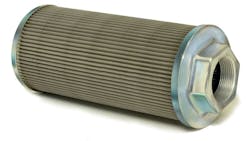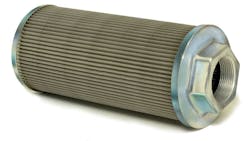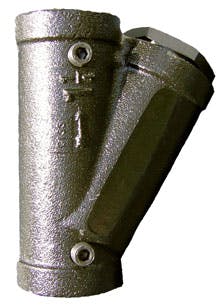This file type includes high resolution graphics and schematics when applicable.
Keeping fluid clean by controlling contamination is essential for ensuring long life of all components in any hydraulic system. And because the pump is the most critical component in a hydraulic system, you should start by keeping contaminants out of the pump’s suction line.
Questions sometimes arise as to whether or not you should provide a suction strainer (screen) for a system’s main hydraulic pump. In my view, the answer is yes, absolutely. End of story. But if you still need some convincing, read on.
However, before proceeding, let’s define a key term: strainer. At Flow-Ezy, we define straining as using a 200-mesh (74 µm) or courser screen to keep solid contaminants out of the pump. Anything finer than that—especially when the element is something other than a screen—we consider filtering. So this discussion refers to pump suction strainers.
The Role of Strainers
Suction strainers serve one purpose and one purpose only: to protect the pump from ingesting large (about 75 µm or larger) particles. When a pump fails for any reason, the hydraulic system becomes useless. Pumps are rugged and can tolerate some pretty hostile conditions—up to a point. Suction strainers are designed to keep large contaminants out of the pump while creating little or no restriction to flow. An excessive restriction causes the pump to cavitate, which can quickly lead to premature pump failure.
Cavitation begins with the formation of vapor cavities (bubbles) when hydraulic fluid is at low pressure. Cavitation occurs when the fluid pressure increases rapidly, as when fluid is pressurized within the hydraulic pump. When subjected to the sudden increase in pressure inside the pump, the voids collapse (implode), generating an intense shock wave that can erode away internal surfaces of the pump. Because these implosions occur repeatedly at high frequency, pumps can be rendered unserviceable within hours of operation.
The first component hydraulic fluid passes through is the pump. Knowing that contamination, by far, is the No. 1 cause of hydraulic system failure, your No. 1 priority should be to protect the pump from particles large enough to damage a pump. Some pump manufacturers say that no filtration should be in the suction line, whereas others say there should. Regardless, all pump manufacturers agree that placing too tight of a filtration device in the suction line could wreak havoc on the pump. The bottom line is that placing a suction strainer in the suction line—and keeping the level of filtration open enough so as not to cause cavitation— becomes a win-win situation.
Knowing the importance of protecting pumps from large contaminants, how fine a screen should be used for straining fluid drawn into the pump? It depends on the type of pump and its operating pressure. Listed below are some good general rules to follow in determining how fine a suction screen should be specified. But no matter what pump design is used and its operating pressure, assuming hydraulic fluid with a viscosity of 150 SUS at 100°F, the suction line flow rate should never exceed 4 ft/sec, and 2 ft/sec is even better.
Piston pumps operating at low pressure (500 psi or less) should use a 100-mesh (149 µm) screen. For operating pressure from 1,000 to 2,000 psi, use a 200-mesh (74 µm) screen.
Vane pumps can tolerate larger contamination particles than piston pumps can, so for vane pumps operating at low pressure (500 psi or less), use 60-mesh (238 µm) screen. For operating pressure from 1,000 to 5,000 psi, use a 100-mesh (149 µm) screen.
Gear pumps are even more tolerant of larger particles when operating at low pressure. For gear pumps operating at pressure of 500 psi or less, use a 30-mesh screen. For pressures of 1,000 to 3,000 psi, use a 100-mesh (149 µ) screen.
Keep in mind, these are general rules for unspecified applications. One thing that’s certain is that many different systems operate in many different applications performing many different functions. Consult a certified filtration specialist if you have any questions or concerns regarding your specific application and equipment.
Should Strainers Have a Bypass?
Let’s answer this question with a question. Are there ever times that unfiltered fluid should be allowed to pass through the pump? The answer is yes, especially if a system requires cold-weather startup.
Before starting your system up in the cold, ensure that you have a bypass in place to allow unfiltered fluid to pass through the pump. Startup is a temporary event, and as long as you set the bypass in cold weather, there should be no harm to the pump. Trying to start it in the cold weather without a bypass may cause the pump to cavitate, creating problems. Another option for cold weather startup is to oversize the strainer, which offers more surface area for filtration. This will reduce the pressure drop caused by restricted flow. You may even consider using a coarser filter (larger openings) than what is generally used. Consider each application’s total operation. Most suction strainers are available either with or without a bypass option. Some modifications may also be made when using more viscous fluids.
Remember to always consider collectively what type of pump is being used, the viscosity of the fluid, the flow rate, the system pressure, and the line size in your selection. The suction line is never a place for filtering—a term generally used for anything finer than 74 µm; it is normally a place for “straining” (coarser than 74 micron). Make sure your strainer is sized properly for the application.
Suction strainers are not meant to be a system’s only defense against contamination. I have yet to hear a valid reason for not using suction strainers, providing they are installed properly. Filters should to be installed in the pressure line, the return line, and the filler-breather port or tank breather, because airborne particles carry destructive contaminants, too. It is also a wise decision to use a portable filtration device—a filter cart, for example—to clean and polish the fluid in the system at scheduled intervals.
A familiar term known to many is “reactive” maintenance. This is when you fix a problem only after noticing that something has gone terribly wrong. My advice is to remain one step ahead in servicing and maintaining your system at all times. My philosophy has always been, if you don’t have time to do it right the first time, how are you ever going to find the time to fix it when it breaks?
Take a proactive approach to ensure your hydraulic system’s proper operation and longevity. This includes careful system design, regular monitoring, fluid analysis, and preventive maintenance. A suction strainer is an inexpensive and effective investment intended to prolong the life of a hydraulic system’s pump.
Don Krause is general manager, Flow Ezy Filters Inc., Ann Arbor, Mich.
This file type includes high resolution graphics and schematics when applicable.
About the Author

Leaders relevant to this article:



